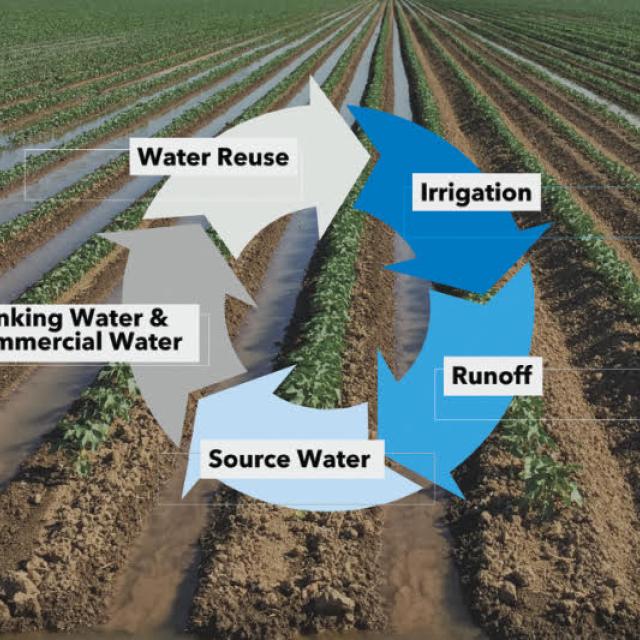A lot of ink has been spilled in the past few years about two important topics: circular economies and carbon capture. Both themes center around agriculture, and both become even more powerful and relevant in irrigated systems. After all, smart irrigation is where the rubber meets the road.

The circular water economy begins with source water, which is divided into drinking water and commercial water. After it is used, it undergoes treatment—a key step that makes this a circular system rather than a linear one in which water is discharged and flows downstream. After treatment, water in a circular system is reused, whether as commercial water (heating, cooling or cleaning in an industrial setting), drinking water (in advanced settings like Singapore's NEWater system) or as irrigation water. Runoff or infiltration from irrigated fields replenishes source water supplies, and the cycle begins again.
As water rounds that circle in irrigated fields, it contributes significantly to another powerful tool that puts farmers at the center of sustainability—carbon capture. Agriculture's superpower is its cultivation of plants that capture carbon from the atmosphere and fix it in the soil as stable organic matter. That carbon sequestration, or capture, removes greenhouse gases from the atmosphere, helping reduce global warming. At the same time, it builds healthy soils, feeding a vibrant microbial ecosystem and creating another circular pathway that taps soil nutrients to nurture plant growth, then breaks down dead plant matter to reclaim its nutrients and carbon to replenish the soil. As that cycle rolls along, farmers harvest food, fuel and fiber.
Irrigation supercharges the carbon capture system in several ways, first by increasing yields and reducing the risk of plant growth shortfalls from drought. That helps ensure that the plants are indeed able to capture carbon in the first place.
Powerful Alternative
Using agriculture is the most efficient approach to capture carbon while providing the exceptional benefit of feeding the world. Engineers and dreamers are often drawn to the sex appeal of high-tech solutions, like machinery that grabs carbon dioxide, concentrates it, and pumps it underground, or using low-oxygen pyrolysis to burn biomass into biochar. When the Lawrence Livermore National Laboratory published its “Getting to Neutral” report, the pages were full of these tech-bait approaches. The closest they got to tapping agriculture’s potential for carbon capture was what the authors called “purpose-grown crops” produced for biomass that could fuel the pyrolysis plants, or thick stands of trees that could become stockpiles of carbon.
The irony was lost on the authors of the report that their laboratory is nearly as close to some of the world's most productive farmland as it is to the skunkworks of Silicon Valley that had clearly grabbed their attention.
Irrigation: Level Up
The rich fields of California’s Central Valley, fruit-growing foothills, and abundant coastal valleys are the envy of farmers around the world. They are fed by a remarkable pair of irrigation systems, including the federal Central Valley Project and the state-funded California Aqueduct. In the hands of California farmers, that precious irrigation water produces a bounty of fruits, nuts, vegetables, grain, oilseeds, meat and more—abundant nourishment and bustling economies. One will never see that from biochar or standing forests preserved in amber for their carbon value.
As a tech success story, irrigation is probably one of the most dramatic and consequential, not least in California. Between 1984 and 2018, drip irrigation acreage rocketed 900% in the state, according to the California Farm Water Coalition, while sprinkler irrigation dropped 49.9% and gravity/flood irrigation acres fell 33.7%.
Drip irrigation, particularly subsurface drip, lends itself perfectly to smart irrigation, a vital aspect of precision farming. With the control of water delivery comes the precise control of water volume and timing, as well as the volume, timing and placement of nutrients and pesticides. Yields—and therefore the conversion of carbon into crops—increase, as does the ratio of crop per drop, and crop per pound of applied nutrients. Irrigation becomes a tool in the 4Rs of Nutrient Stewardship, helping farmers deliver the right nutrient source at the right rate, at the right time, to the right place.
More efficient use of fertilizers—particularly nitrogen, which is largely made from natural gas in an energy-intensive reaction—directly reduces the consumption of greenhouse gases. It can contribute to reductions of nitrates in groundwater that contribute to blue baby syndrome, or nitrogen in surface waters that feed harmful algal blooms in the Gulf of Mexico and other saltwater bodies. And using irrigation water to deliver nutrients to crop roots can reduce exhaust-emitting passes with tractors and spreaders.
Chemistry Lesson
Subsurface placement of nutrients—without energy-intensive tillage or drawing a shank through the soil—also reduces the emission of greenhouse gases and smog precursors from fertilizers undergoing chemical conversions on the soil surface. Nitrogen fertilizers can release ammonia, nitrous oxide and nitric oxide as they undergo the nitrification and denitrification processes in the soil.
In fact, the U.S. Environmental Protection Agency estimates that 74% of the nitrous oxide emitted in the U.S. comes from agricultural soils. A paper in Science Advances estimates that 25 to 40% of the nitrogen oxide emissions in California are released by agricultural soils in the Central Valley.
For farmers, that represents a double loss: first, because it puts them in the crosshairs of the environmental community, and second, because that lost nitrogen is something they paid to acquire and apply that is no longer available to their crops.
Researchers in the U.S. and Canada have also demonstrated that aerating subsurface drip irrigation water through an AirJection system causes a shift in soil microbe populations toward higher proportions of aerobic bacteria, particularly denitrifying bacteria that fix nitrogen in soils. Research continues into the impact of that shift on nutrient use efficiency and emissions.
AirJection has been called “plowing without a plow”—aerating the root zone without the physical disturbance farmers used to count on to create an aerated seedbed. By exposing buried organic matter—carbon—to the air, tillage causes the release of stored carbon, the reverse of sequestration. Through aerated subsurface drip irrigation, farmers keep already-stored carbon safely in the soil, then add to it with the biomass they grow with their irrigation water.
Closed Systems Open Opportunities
Smart irrigation is also the foundation of successful indoor agriculture. Whether conventional glasshouses or today’s ultra-high-tech vertical farming systems, indoor agriculture can be the very model of closed-system farming that fosters a circular water economy and taps into the possibilities of reduced energy consumption and emissions from water efficiency.
In a closed system, the 4Rs can be observed to the finest level.
Combining smart irrigation technology and farmers’ ingenuity and commitment, irrigated agriculture can be the most powerful and efficient force for environmental change in the world. If mankind is going to mitigate climate change and build resilience into global food production through emissions reduction and carbon capture, the best first step is harnessing the power of irrigated agriculture.

